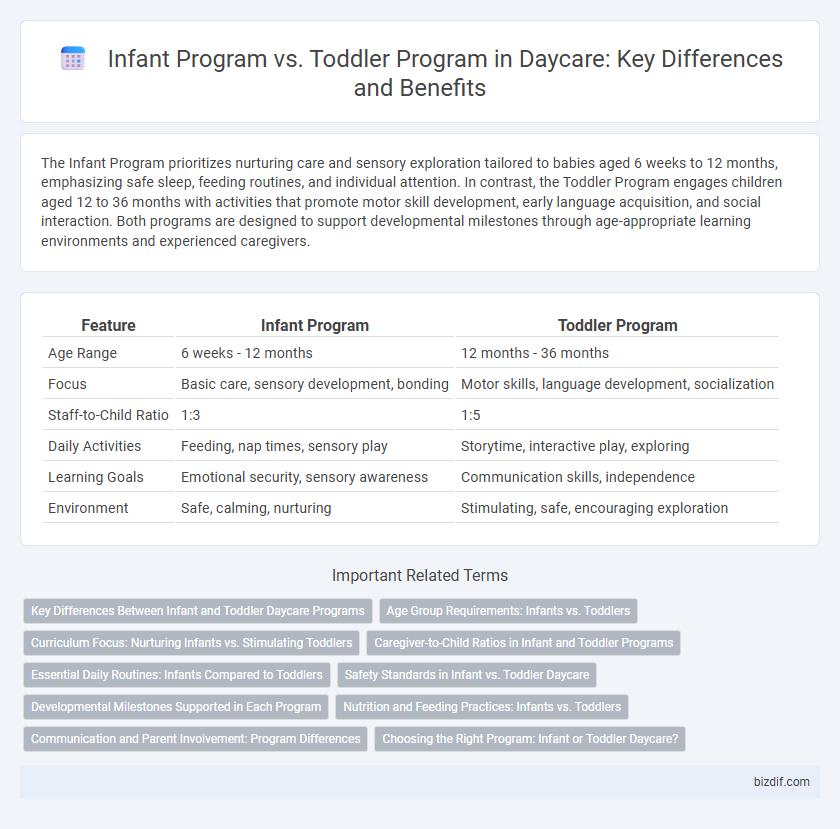The Infant Program prioritizes nurturing care and sensory exploration tailored to babies aged 6 weeks to 12 months, emphasizing safe sleep, feeding routines, and individual attention. In contrast, the Toddler Program engages children aged 12 to 36 months with activities that promote motor skill development, early language acquisition, and social interaction. Both programs are designed to support developmental milestones through age-appropriate learning environments and experienced caregivers.
Table of Comparison
| Feature | Infant Program | Toddler Program |
|---|---|---|
| Age Range | 6 weeks - 12 months | 12 months - 36 months |
| Focus | Basic care, sensory development, bonding | Motor skills, language development, socialization |
| Staff-to-Child Ratio | 1:3 | 1:5 |
| Daily Activities | Feeding, nap times, sensory play | Storytime, interactive play, exploring |
| Learning Goals | Emotional security, sensory awareness | Communication skills, independence |
| Environment | Safe, calming, nurturing | Stimulating, safe, encouraging exploration |
Key Differences Between Infant and Toddler Daycare Programs
Infant daycare programs prioritize sensory exploration and one-on-one care to support rapid brain development and attachment, while toddler programs emphasize socialization, language skills, and motor development through group activities and guided play. Infants require a higher caregiver-to-child ratio to meet their individual needs, whereas toddlers benefit from structured routines that promote independence and peer interaction. Safety considerations differ, with infant spaces designed to prevent choking hazards and toddler environments equipped for active exploration and climbing.
Age Group Requirements: Infants vs. Toddlers
Infant programs typically cater to children aged 6 weeks to 12 months, emphasizing individualized care with a low child-to-caregiver ratio to support developing sensory and motor skills. Toddler programs are designed for children aged 12 months to 36 months, focusing on fostering early language, socialization, and mobility through structured learning activities. Enrollment criteria often require infants to have completed newborn health screenings, while toddlers must demonstrate basic mobility skills for group participation.
Curriculum Focus: Nurturing Infants vs. Stimulating Toddlers
The Infant Program emphasizes nurturing through sensory exploration, gentle routines, and responsive caregiving to support early brain development and emotional bonding. The Toddler Program centers on stimulating cognitive and motor skills with interactive activities, language development, and social interaction to foster independence and curiosity. Both curricula are designed to meet developmental milestones appropriate for each age group, ensuring a tailored learning environment.
Caregiver-to-Child Ratios in Infant and Toddler Programs
Infant programs typically maintain a caregiver-to-child ratio of 1:3 or 1:4 to ensure attentive, individualized care during critical developmental stages, while toddler programs usually have a slightly higher ratio of 1:5 or 1:6 to support increased mobility and social interaction. These ratios align with licensing standards from organizations such as the National Association for the Education of Young Children (NAEYC), promoting safety and quality care. Optimal caregiver-to-child ratios enhance developmental outcomes by allowing caregivers to respond promptly to the unique needs of infants and toddlers.
Essential Daily Routines: Infants Compared to Toddlers
Infant programs prioritize essential daily routines centered around feeding on demand, multiple diaper changes, and frequent naps to support rapid growth and development. Toddler programs focus on more structured routines including scheduled meals, toilet training assistance, and designated activity times promoting independence and social skills. Both programs tailor routines to developmental milestones ensuring safety, comfort, and emotional well-being in daycare settings.
Safety Standards in Infant vs. Toddler Daycare
Infant and toddler daycare programs adhere to rigorous safety standards tailored to each age group's unique needs, ensuring a secure environment for early development. Infant programs emphasize safe sleep practices, such as crib safety and monitored napping, along with constant supervision to prevent choking hazards, while toddler programs focus on child-proofed play areas, fall prevention, and promoting safe exploration. Both programs comply with state and national regulations like those from the American Academy of Pediatrics and licensing agencies, but the safety protocols differ to accommodate the developmental stages of infants versus toddlers.
Developmental Milestones Supported in Each Program
Infant programs focus on supporting developmental milestones such as sensory exploration, basic motor skills like crawling and sitting, and early social interactions including bonding and attachment. Toddler programs emphasize advancing gross motor skills like walking and climbing, language development through increased vocabulary and simple sentences, and cognitive abilities such as problem-solving and basic imaginative play. Both programs cater to age-appropriate developmental needs, promoting growth in physical, emotional, and cognitive domains.
Nutrition and Feeding Practices: Infants vs. Toddlers
Infant programs emphasize breast milk or formula as primary nutrition, introducing pureed or mashed foods around six months, with careful monitoring for allergies and gradual texture progression. Toddler programs focus on balanced meals incorporating a variety of solid foods, encouraging self-feeding skills and offering portion-appropriate snacks to support growing energy needs. Both programs prioritize scheduled feeding times, hydration, and responsive feeding practices to promote healthy eating habits and development.
Communication and Parent Involvement: Program Differences
The Infant Program emphasizes gentle communication techniques, such as soothing tones and nonverbal cues, ensuring caregivers build trust and emotional bonds with newborns. In contrast, the Toddler Program focuses on interactive communication strategies, encouraging verbal skills and social interactions through storytelling and group activities. Parent involvement in the Infant Program centers on daily report sharing and personalized care updates, while the Toddler Program promotes active participation in developmental milestones and collaborative learning experiences.
Choosing the Right Program: Infant or Toddler Daycare?
Choosing the right daycare program depends on your child's developmental stage, as infant programs focus on sensory stimulation, individualized care, and safe exploration for ages 6 weeks to 12 months, while toddler programs emphasize socialization, language development, and motor skills for children 1 to 3 years old. Infant daycare centers prioritize low child-to-caregiver ratios and responsive feeding schedules, whereas toddler programs introduce structured activities and group interactions to foster independence and cognitive growth. Evaluating your child's needs alongside program curricula and caregiver qualifications ensures the best environment for early learning and emotional security.
Infant Program vs Toddler Program Infographic

 bizdif.com
bizdif.com